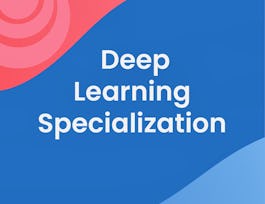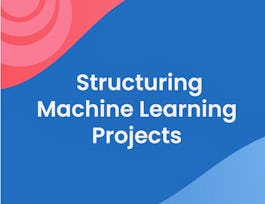E-Learning: The Business Case for Your Organization
November 21, 2023
Article

New year. Big goals. Bigger savings. Unlock a year of unlimited access to learning with Coursera Plus for $199. Save now.


(673 reviews)
(673 reviews)

Add to your LinkedIn profile
10 assignments


Add this credential to your LinkedIn profile, resume, or CV
Share it on social media and in your performance review

Your smartphone, smartwatch, and automobile (if it is a newer model) have AI (Artificial Intelligence) inside serving you every day. In the near future, more advanced “self-learning” capable DL (Deep Learning) and ML (Machine Learning) technology will be used in almost every aspect of your business and industry. So now is the right time to learn what DL and ML is and how to use it in advantage of your company. This course has three parts, where the first part focuses on DL and ML technology based future business strategy including details on new state-of-the-art products/services and open source DL software, which are the future enablers. The second part focuses on the core technologies of DL and ML systems, which include NN (Neural Network), CNN (Convolutional NN), and RNN (Recurrent NN) systems. The third part focuses on four TensorFlow Playground projects, where experience on designing DL NNs can be gained using an easy and fun yet very powerful application called the TensorFlow Playground. This course was designed to help you build business strategies and enable you to conduct technical planning on new DL and ML services and products.
For the course “Deep Learning for Business,” the first module is “Deep Learning Products & Services,” which starts with the lecture “Future Industry Evolution & Artificial Intelligence” that explains past, current, and future industry evolutions and how DL (Deep Learning) and ML (Machine Learning) technology will be used in almost every aspect of future industry in the near future. The following lectures look into the hottest DL and ML products and services that are exciting the business world. First, the “Jeopardy!” winning versatile IBM Watson is introduced along with its DeepQA and AdaptWatson systems that use DL technology. Then the Amazon Echo and Echo Dot products are introduced along with the Alexa cloud based DL personal assistant that uses ASR (Automated Speech Recognition) and NLU (Natural Language Understanding) technology. The next lecture focuses on LettuceBot, which is a DL system that plants lettuce seeds with automatic fertilizer and herbicide nozzles control. Then the computer vision based DL blood cells analysis diagnostic system Athelas is introduced followed by the introduction of a classical and symphonic music composing DL system named AIVA (Artificial Intelligence Virtual Artist). As the last topic of module 1, the upcoming Apple watchOS 4 and the HomePod speaker that was presented at Apple's 2017 WWDC (World Wide Developers Conference) is introduced.
5 videos2 assignments
The second module “Business with Deep Learning & Machine Learning” first focuses on various business considerations based on changes to come due to DL (Deep Learning) and ML (Machine Learning) technology in the lecture “Business Considerations in the Machine Learning Era.” In the following lecture “Business Strategy with Machine Learning & Deep Learning” explains the changes that are needed to be more successful in business, and provides an example of business strategy modeling based on the three stages of preparation, business modeling, and model rechecking & adaptation. The next lecture “Why is Deep Learning Popular Now?” explains the changes in recent technology and support systems that enable the DL systems to perform with amazing speed, accuracy, and reliability. The last lecture “Characteristics of Businesses with DL & ML” first explains DL and ML based business characteristics based on data types, followed by DL & ML deployment options, the competitive landscape, and future opportunities are also introduced.
4 videos2 assignments1 discussion prompt
The third module “Deep Learning Computing Systems & Software” focuses on the most significant DL (Deep Learning) and ML (Machine Learning) systems and software. Except for the NVIDIA DGX-1, the introduced DL systems and software in this module are not for sale, and therefore, may not seem to be important for business at first glance. But in reality, the companies that created these systems and software are indeed the true leaders of the future DL and ML business era. Therefore, this module introduces the true state-of-the-art level of DL and ML technology. The first lecture introduces the most popular DL open source software TensorFlow, CNTK (Cognitive Toolkit), Keras, Caffe, Theano, and their characteristics. Due to their popularly, strong influence, and diverse capabilities, the following lectures introduce the details of Google TensorFlow and Microsoft CNTK. Next, NVIDIA’s supercomputer DGX-1, that has fully integrated customized DL hardware and software, is introduced. In the following lectures, the most interesting competition of human versus machine is introduced in the Google AlphaGo lecture, and in the ILSVRC (ImageNet Large Scale Visual Recognition Challenge) lecture, the results of competition between cutting edge DL systems is introduced and the winning performance for each year is compared.
4 videos2 assignments
The module “Basics of Deep Learning Neural Networks” first focuses on explaining the technical differences of AI (Artificial Intelligence), ML (Machine Learning), and DL (Deep Learning) in the first lecture titled “What is DL (Deep Learning) and ML (Machine Learning).” In addition, the characteristics of CPUs (Central Processing Units) and GPUs (Graphics Processing Units) used in DL as well as the representative computer performance units of FLOPS (FLoating-Point Operations Per Second) and IPS (Instructions Per Second) are introduced. Next, in the NN (Neural Network) lecture, the biological neuron (nerve cell) and its signal transfer is introduced followed by an ANN (Artificial Neural Network) model of a neuron based on a threshold logic unit and soft output activation functions is introduced. Then the extended NN technologies that uses MLP (Multi-Layer Perceptron), SoftMax, and AutoEncoder are explained. In the last lecture of the module, NN learning based on backpropagation is introduced along with the learning method types, which include supervised learning, unsupervised learning, semi-supervised learning, and reinforcement learning.
3 videos2 assignments
The module “Deep Learning with CNN & RNN” focuses on CNN (Convolutional Neural Network) and RNN (Recurrent Neural Network) technology that enable DL (Deep Learning). First the lectures introduce how CNNs used in image/video recognition, recommender systems, natural language processing, and games (like Chess and Go) are made possible through processing in the convolutional layer and feature maps. The lecture also introduces how CNNs use subsampling (pooling), LCN (Local Contrast Normalization), dropout, ensemble, and bagging technology to become more efficient, reliable, robust, and accurate. Next, the lectures introduce how DL with RNN is used in speech recognition (as in Apple's Siri, Google’s Voice Search, and Samsung's S Voice), handwriting recognition, sequence data analysis, and program code generation. Then the details of RNN technologies are introduced, which include S2S (Sequence to Sequence) learning, forward RNN, backward RNN, representation techniques, context based projection, and representation with attention. As the last part of the module, the early model of RNN, which is the FRNN (Fully Recurrent NN), and the currently popular RNN model LSTM (Long Short-Term Memory) is introduced.
2 videos2 assignments1 discussion prompt
The module “Deep Learning Project with TensorFlow Playground” focuses on four NN (Neural Network) design projects, where experience on designing DL (Deep Learning) NNs can be gained using a fun and powerful application called the TensorFlow Playground. The lectures first teach how to use the TensorFlow Playground, which is followed by guidance on three projects so you can easily buildup experience on using the TensorFlow Playground system. Then in Project 4 a “DL NN Design Challenge” is given, where you will need to make the NN “Deeper” by adding hidden layers and neurons to satisfy the classification objectives. The knowledge you obtained in the lecture of Modules 1~5 will be used in these projects.
3 videos1 discussion prompt
We asked all learners to give feedback on our instructors based on the quality of their teaching style.



Yonsei University was established in 1885 and is the oldest private university in Korea. Yonsei’s main campus is situated minutes away from the economic, political, and cultural centers of Seoul’s metropolitan downtown. Yonsei has 3,500 eminent faculty members who are conducting cutting-edge research across all academic disciplines. There are 18 graduate schools, 22 colleges and 133 subsidiary institutions hosting a selective pool of students from around the world. Yonsei is proud of its history and reputation as a leading institution of higher education and research in Asia.
Course

DeepLearning.AI
Specialization

DeepLearning.AI
Course




673 reviews
61.72%
26.26%
6.97%
3.11%
1.92%
Showing 3 of 673
Reviewed on Mar 2, 2019
Even though I do not have the background of Computer Engineering or Science I was able to understand from the professor and the final project truly was able to explain everything for me.
Reviewed on Feb 13, 2020
Great course, especially for the people who are implementing NN's into their business models to investigate inefficiencies and automate human tasks as much as possible.
Reviewed on Apr 28, 2018
Good Introductory course for those from a business background. But if you have technical skills, then probably another course (Machine Learning from Andrew Ng may be a better one).

Unlimited access to 10,000+ world-class courses, hands-on projects, and job-ready certificate programs - all included in your subscription
Earn a degree from world-class universities - 100% online
Upskill your employees to excel in the digital economy
Access to lectures and assignments depends on your type of enrollment. If you take a course in audit mode, you will be able to see most course materials for free. To access graded assignments and to earn a Certificate, you will need to purchase the Certificate experience, during or after your audit. If you don't see the audit option:
The course may not offer an audit option. You can try a Free Trial instead, or apply for Financial Aid.
The course may offer 'Full Course, No Certificate' instead. This option lets you see all course materials, submit required assessments, and get a final grade. This also means that you will not be able to purchase a Certificate experience.
When you purchase a Certificate you get access to all course materials, including graded assignments. Upon completing the course, your electronic Certificate will be added to your Accomplishments page - from there, you can print your Certificate or add it to your LinkedIn profile. If you only want to read and view the course content, you can audit the course for free.
You will be eligible for a full refund until two weeks after your payment date, or (for courses that have just launched) until two weeks after the first session of the course begins, whichever is later. You cannot receive a refund once you’ve earned a Course Certificate, even if you complete the course within the two-week refund period. See our full refund policy.
Yes. In select learning programs, you can apply for financial aid or a scholarship if you can’t afford the enrollment fee. If fin aid or scholarship is available for your learning program selection, you’ll find a link to apply on the description page.